Your Age as the Telltale Sign of COVID-19 Habits
Your Age as the Telltale Sign of COVID-19 Habits
When it comes to our habits during COVID-19 – and whether those habits will stick after the pandemic - it turns out that one’s age can tell us quite a bit
Visits to the doctor were mostly in-person
When it comes to seeing health care professionals during COVID-19, nearly half (48%) saw them in-person only, with one-in-five (21%) reporting that they went both went in-person and virtually. Significantly less conducted these visits only online (12%) and surprisingly, nearly one-in-five (19%) didn’t see any medical professionals over the past year.
Those who went in-person skewed older; specifically, this includes over half of those 45-64 (54%) and 65+ years of age (55%) and only 40% of those under 45. The converse – only virtual – skews younger with less than one-in-ten 45-64 years old and 65+ (8% and 7%, respectively) compared to 18% of those under 45.
Nearly seven-in-10 (68%) of those who saw a health professional in person said their medical needs required it. Only 5% said it was because they lacked the technology/tools to have a virtual visit.
Income is also an important indicator here, with nearly one-quarter (23%) of those making less than $40,000/year reporting that they didn’t see any health professionals over the past year (compared to 18% of those earning between $40,000-80,000/year and only 10% of those earning over $80,000/year).
Once American’s are vaccinated, the percentage of those who say they’ll make only in-person appointments is nearly identical to what is currently reported (49% vs. 48% currently). This includes a greater percentage of older adults (62% of those 65+ compared to 51% of those 45-64 and 41% of those under 45). Americans who do want to continue with virtual appointments note their convenience, the feeling that it’s safer and that they’ve received good, quality care in a virtual setting.
Vast majority shopped for at least some groceries in person
Throughout the pandemic, nearly nine in 10 (88%) did at least some grocery shopping in-person; 65% said they only shopped in-person. Fewer than one-in-10 (9%) report exclusively shopping online. Perhaps unsurprisingly, those who buy all their groceries in-person tend to be older, with over three-quarters (78%) of those 65+ compared to 72% of Americans 45-64 and only 55% of those under 45). Food shopping exclusively online – even during the pandemic – capped at 12% of those under 45; only 7% of Americans 45-64 and 5% of individuals over 65 shopping only online.
Half said their number one reason for shopping in-person is to select foods themselves, higher still among older adults (63% of those over 65); nearly one-third (29%) said their top reason was ease/convenience.
Working in-person daily is more common among younger adults
When it comes to working in-person during COVID-19, Americans are split – however, younger adults are more likely to work outside their home every day. Half of individuals surveyed have not worked at all in-person throughout the pandemic; one-third say they’ve gone in more than once-a-month and about two-in-ten (19%) report going every day (24% for those under 45). The converse is as one might suspect – the percent of those who never went to work in-person during the day was significantly higher for older adults (83% of those 65+ compared to 56% of those 45-64 and only 34% of those under 45)
Over half (59%) go in-person because they say their job can only be done in-person. About one-third (31%) say it’s because their supervisor requires them to go in-person. One-quarter (25%) say they feel they can do a better job working in-person.
Vaccine hesitancy
As the push to get Americans vaccinated continues, more than one-quarter of individuals reported not wanting to be vaccinated (some offered the vaccine, some not yet offered). Those who remain vaccine-hesitant are younger adults – nearly one-in-five (19%) have not yet been offered the vaccine say they don’t want it. The number drops with age – 13% of those individuals 45-64 and 8% of those over 65 report not being offered and not wanting the vaccine.
Methodology
1,054 interviews among adults age 18+ were conducted from May 6-10, 2021, using an online survey. The results were weighted to ensure proportional responses. The Bayesian confidence interval for 1,000 interviews is 3.5, which is roughly equivalent to a margin of error of ±3.1 at the 95% confidence level.
The Root Cause Coalition
Co-founded by AARP Foundation and ProMedica in 2015, The Root Cause Coalition is a non-profit member-driven organization comprised of more than 90 leading health systems, hospital associations, foundations, businesses, national and community nonprofits, health insurers, academic institutions, local governments and policy centers. Our common goal is to achieve health equity for every American.
Please click here to view the full report.
Contact: Alexandra Lewin-Zwerdling
alexandra@rootcausecoalition.org
202.769.9015
